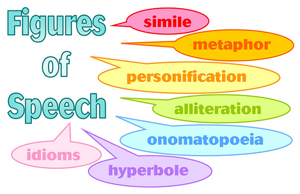
Source: Figures of Speech, Enokson, Flickr
Polishing your draft by adding figurative language is like decorating a birthday cake. It wouldn’t be much of a cake without icing, flowers, candles, and sprinkles. You might even want plastic figures or more than two layers. In the same way, you can enhance your writing with four important types of figurative language: simile, metaphor, personification, and hyperbole. Think of these as the icing, flowers, candles, and sprinkles on your birthday cake.
Simile and Metaphor
Simile and metaphor can be especially effective as you refine the draft of an essay. They both compare seemingly unlike things, but a simile includes the word like or as; a metaphor doesn’t. It creates a link without any help from those words.
Consider this famous line from the movie Forrest Gump: “Life is like a box of chocolates.” In what ways are life and a box of chocolates similar? Think about this question and then check your understanding to see a possible response.
You might have responded that life, like a box of chocolates, presents many choices, some more appealing than others.
What if you want to show how fast a certain relay team is? You might write, “They are lightning bolts” or “They are bullets shot from a gun.” Your audience then pictures the runners shooting down the track.
Similes and metaphors show your audience an image (i.e., a box of chocolates). Suppose you want to demonstrate that a young woman is very slender. You might write, “She is as thin as a toothpick” or “She is as thin as a beanpole.” Notice, though, that both have negative connotations. It isn't desirable to be "thin as a toothpick." If you wanted to create a positive impression, you could say "She is as slender as a vase," or "She is as slender as a flower stem." Your audience then envisions exactly how slight the young woman is. Depending on how you want to cast the subject, choose comparisons with positive or negative connotations. As we saw in the previous section about verbs and adjectives, one key to good style is choosing words that match the effect you want to create.
 Using your notes, write similes that convey the images listed below. Your responses should be complete sentences. When you’re finished, check your understanding to see a possible response. Answers will vary.
Using your notes, write similes that convey the images listed below. Your responses should be complete sentences. When you’re finished, check your understanding to see a possible response. Answers will vary. - that you had too much homework (Hint: Begin with the words Trying to finish my homework tonight is like—)
- that writing an essay is challenging
- Trying to finish my homework tonight is like traveling across Texas in a covered wagon.
- Writing an essay is like stitching together a quilt.
 Now return to your notes. Using your answers from the previous two questions, choose one metaphor to extend. Read the example of an extended metaphor in Richard Wilbur’s poem “The Writer.” When you are finished, check your understanding to see a possible response.
Now return to your notes. Using your answers from the previous two questions, choose one metaphor to extend. Read the example of an extended metaphor in Richard Wilbur’s poem “The Writer.” When you are finished, check your understanding to see a possible response. An extended metaphor is a metaphor in which the comparison is carried through several lines or even the entire literary work. In Wilbur’s there are three extended metaphors. Let’s take a look at one of them.
In her room at the prow of the house
Where light breaks, and the windows are tossed with linden,
My daughter is writing a story.
I pause in the stairwell, hearing
From her shut door a commotion of typewriter-keys
Like a chain hauled over a gunwale.
Young as she is, the stuff
Of her life is a great cargo, and some of it heavy:
wish her a lucky passage.
Wilbur is comparing his daughter’s life to a ship’s voyage here in the first three stanzas. To begin with, she’s “writing a story” or living her life so to speak, in her room “at the prow (the forward part of a ship’s bow)” of the house. The father goes on to describe her life struggles are “great cargo, and some of it heavy,” (line 8). Also, he wishes his daughter a “lucky passage” (9), like the wishes sent to passengers on a ship about to set sail. These expressions show how a journey at sea is like the journey through life.

Source: CLICHé, Cliché!, Flickr
Make sure that your similes and metaphors are not cliché. You have probably heard this expression before and know that clichés should be avoided, but here are two examples of clichés or dead metaphors:
- My algebra homework assignment is as clear as mud.
- Writing an essay is like climbing Mount Everest.
Personification
In the personified world, the stars dance, the moon winks, and the wind whispers. Fast cars hurry and slow dogs are tardy for dinner. Personification is an effective tool for description, clarification of ideas, and emphasis.


Source: sun, Leo Reynolds, Flickr
Example: When the wind blows, you can hear the ______ of the tall prairie grass. (Use a verb that refers to a way we communicate verbally.)
Possible Responses: chattering, whispering, gossiping
- The school bus ______________ up the hill (Use a verb that indicates tired and overworked.)
- The tree branch ______________ as I swung from it. (Use a verb that indicates crabby or grumpy.)
- The waffle ______________ up out of the toaster. (Use a verb that indicates athleticism.)
- labored, toiled, sweated, slogged, shambled, trudged, hobbled, staggered
- protested, moaned, complained, griped, grumbled
- bolted, jumped, hurdled, leapt, vaulted

Source: Exaggerated Hyperbole, outtacontext, Flickr
Again, make sure your personification is original and that you have avoided clichés.
Hyperbole
In the hyperbolic world, you might tell your parents that your homework includes reading 1,000 pages of a novel, solving 99 algebraic equations, and finding a cure for a rare, tropical disease contracted from the tsetse fly. The point you are making (in an interesting and humorous way) is that you have way too much homework. Hyperboles convey excess.

For the next exercise, click the box that best shows the excess described in the first part of the sentence.
- She spends so much time on Facebook that she—
- It is so hot in Texas in August that you can—
This section is smiling at you like a kid holding too much candy. You are a silversmith, ready to polish a billion drafts, maybe more! (To see the kinds of figurative language used in the previous two sentences, move your cursor over the words slowly.)